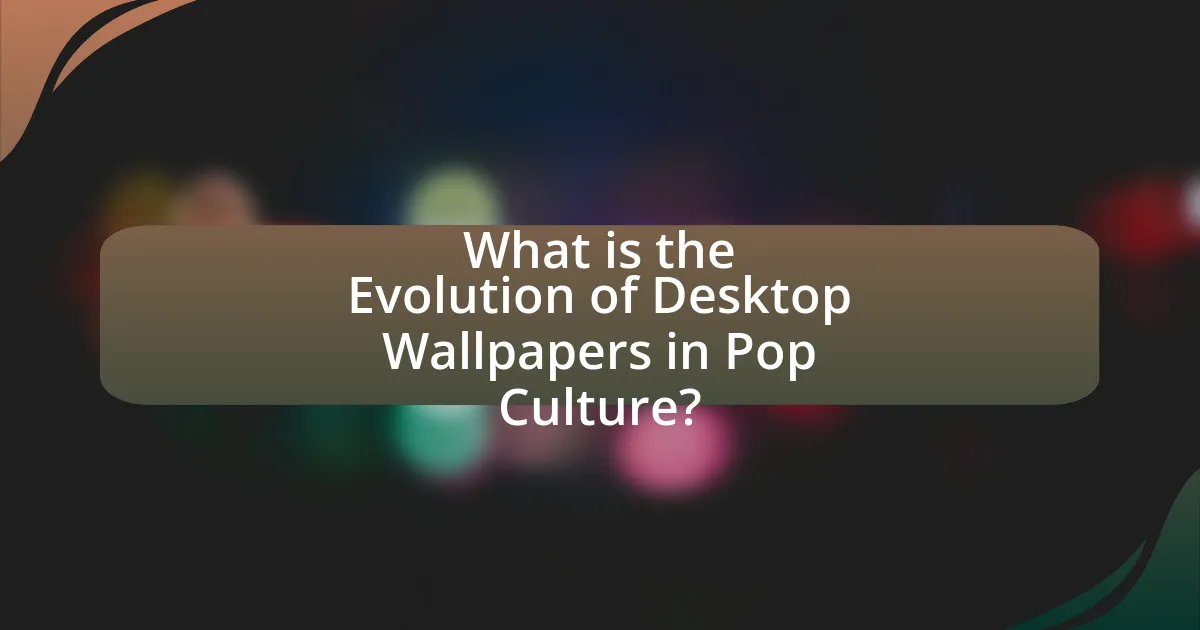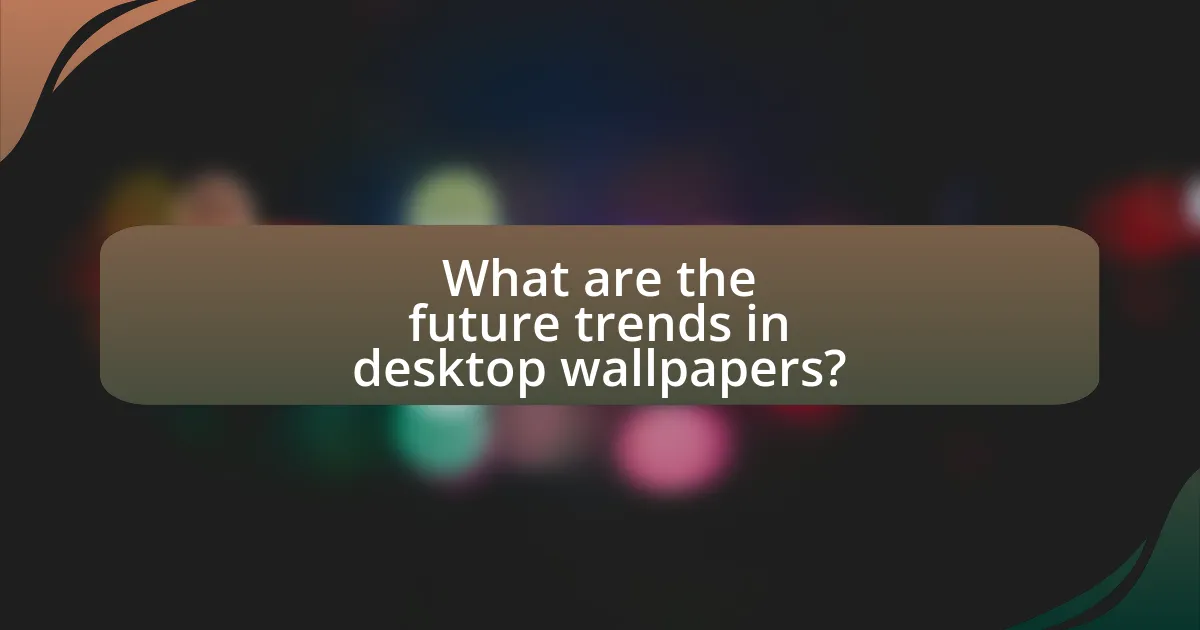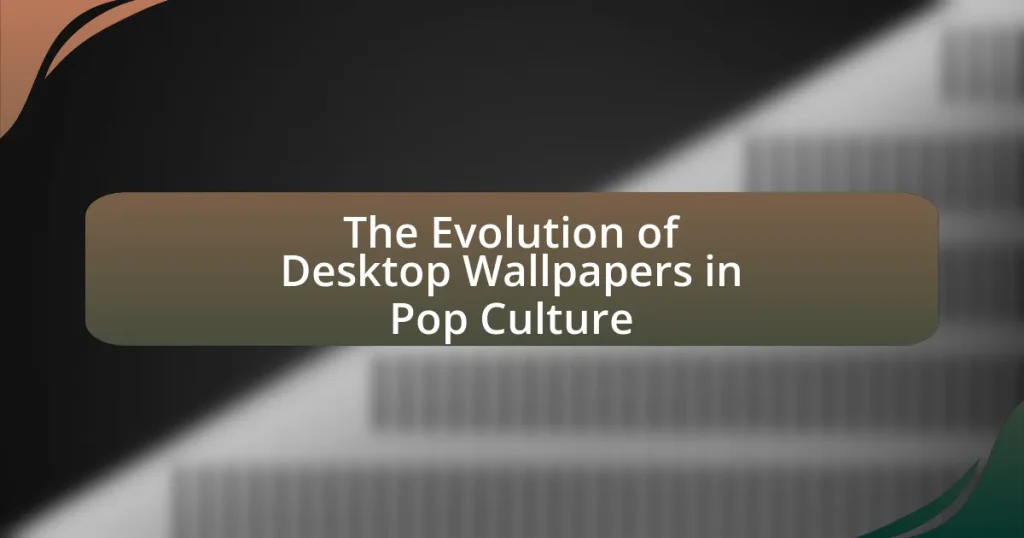The article examines the evolution of desktop wallpapers in pop culture, highlighting their transformation from simple monochromatic designs in the 1980s to dynamic, customizable backgrounds in the digital age. It discusses the impact of technological advancements, such as high-resolution displays and graphic design software, on wallpaper design, as well as the influence of the internet and social media on trends and user preferences. Additionally, the article explores how desktop wallpapers serve as a medium for personal expression and cultural identity, reflecting societal trends and movements, and considers future developments in wallpaper technology, including AI-generated designs and augmented reality.

What is the Evolution of Desktop Wallpapers in Pop Culture?
The evolution of desktop wallpapers in pop culture reflects changing aesthetics, technology, and user preferences over time. Initially, in the early 1980s, desktop backgrounds were simple, monochromatic designs due to limited graphical capabilities. As personal computers became more advanced in the 1990s, wallpapers evolved to include vibrant colors and images, often featuring popular culture icons, landscapes, and abstract art, influenced by the rise of the internet and digital photography.
By the early 2000s, the customization of desktop wallpapers became a form of personal expression, with users creating and sharing their own designs on platforms like DeviantArt. The introduction of high-resolution displays further enhanced the visual quality of wallpapers, leading to a trend of using high-definition images from movies, video games, and art.
In recent years, the rise of mobile devices and social media has shifted the focus towards dynamic wallpapers and animated backgrounds, allowing for more interactive and personalized experiences. This evolution illustrates how desktop wallpapers have transitioned from basic functionality to a significant aspect of digital identity and cultural expression.
How have desktop wallpapers changed over the decades?
Desktop wallpapers have evolved significantly over the decades, transitioning from simple, static images to dynamic, customizable backgrounds. In the 1980s, early computer systems featured basic, monochrome graphics, often limited to solid colors or simple patterns. The 1990s introduced more vibrant graphics with the advent of Windows 95, allowing users to select from a variety of pre-installed images, including nature scenes and abstract designs.
By the 2000s, the rise of high-resolution displays enabled wallpapers to feature intricate details and photography, leading to a surge in user-generated content as individuals began creating and sharing their own designs online. The introduction of widescreen monitors further influenced wallpaper design, prompting a shift towards panoramic images and aspect ratio considerations.
In recent years, the trend has moved towards animated wallpapers and live backgrounds, enhancing user engagement and personalization. This evolution reflects broader technological advancements and changing aesthetic preferences, showcasing how desktop wallpapers have become a form of self-expression in digital culture.
What technological advancements influenced desktop wallpaper design?
Technological advancements such as high-resolution displays, graphic design software, and digital imaging techniques have significantly influenced desktop wallpaper design. High-resolution displays, which became prevalent in the early 2000s, allowed for more detailed and vibrant images, enhancing the visual appeal of wallpapers. Graphic design software like Adobe Photoshop and Illustrator enabled designers to create intricate and customized wallpapers, facilitating artistic expression. Additionally, advancements in digital imaging techniques, including 3D rendering and vector graphics, expanded the creative possibilities for wallpaper designs, allowing for more dynamic and visually engaging backgrounds. These advancements collectively transformed desktop wallpapers from simple patterns to complex, artistic representations that reflect personal style and cultural trends.
How did the rise of the internet impact wallpaper trends?
The rise of the internet significantly transformed wallpaper trends by facilitating access to a vast array of designs and styles. With the emergence of online platforms, users gained the ability to download wallpapers from diverse sources, leading to a democratization of design choices. This shift allowed for rapid dissemination of trends, as popular designs could go viral through social media and websites, influencing user preferences globally. For instance, the introduction of high-resolution images and customizable options on platforms like DeviantArt and Pinterest enabled users to personalize their digital spaces more than ever before, reflecting individual tastes and cultural movements.
Why are desktop wallpapers significant in pop culture?
Desktop wallpapers are significant in pop culture because they serve as a form of personal expression and cultural identity for users. They reflect individual tastes, interests, and affiliations, often showcasing popular media, art, or social movements. For instance, the rise of fandoms around movies, video games, and music has led to the creation of wallpapers that resonate with specific communities, reinforcing group identity. Additionally, the accessibility of digital art and the internet has democratized the creation and sharing of wallpapers, allowing trends to spread rapidly across social media platforms. This phenomenon illustrates how desktop wallpapers not only personalize technology but also contribute to broader cultural dialogues and trends.
What role do wallpapers play in personal expression?
Wallpapers serve as a significant medium for personal expression by allowing individuals to showcase their tastes, interests, and identities through visual aesthetics. The choice of wallpaper can reflect personal values, moods, and preferences, influencing how users perceive their digital environments. For instance, studies indicate that personalized wallpapers can enhance user satisfaction and emotional connection to devices, as seen in research published in the Journal of Human-Computer Interaction, which highlights the psychological impact of customized digital spaces on user experience.
How do wallpapers reflect societal trends and movements?
Wallpapers reflect societal trends and movements by visually representing cultural shifts, technological advancements, and collective sentiments. For instance, during the rise of environmental awareness in the late 20th century, wallpapers featuring nature themes became popular, mirroring society’s growing concern for ecological issues. Similarly, the adoption of minimalist designs in the 2010s coincided with a societal shift towards simplicity and mindfulness, influenced by the digital age’s fast-paced lifestyle. These patterns in wallpaper design serve as a barometer for societal values, illustrating how aesthetics evolve in response to changing cultural narratives and technological progress.
What are the different styles of desktop wallpapers?
Different styles of desktop wallpapers include photographic, abstract, minimalistic, artistic, and themed designs. Photographic wallpapers feature high-resolution images of landscapes, cityscapes, or portraits, often used for their realism and visual impact. Abstract wallpapers utilize shapes, colors, and patterns to create visually stimulating backgrounds, appealing to those who prefer non-representational art. Minimalistic wallpapers focus on simplicity, often using a limited color palette and clean lines, which can enhance productivity by reducing visual clutter. Artistic wallpapers showcase illustrations or digital art, allowing users to express personal tastes and creativity. Themed wallpapers are designed around specific concepts, such as nature, technology, or pop culture, catering to niche interests and preferences. Each style serves different aesthetic and functional purposes, reflecting the diverse tastes of users in the digital age.
What are the most popular themes in desktop wallpapers?
The most popular themes in desktop wallpapers include nature, abstract designs, minimalism, space, and fantasy. Nature-themed wallpapers often feature landscapes, wildlife, and floral imagery, appealing to users who appreciate the outdoors. Abstract designs utilize shapes and colors to create visually striking compositions, while minimalism focuses on simplicity and clean lines. Space-themed wallpapers capture celestial bodies and cosmic phenomena, attracting those fascinated by the universe. Fantasy themes often include mythical creatures and imaginative landscapes, appealing to fans of fantasy genres. These themes reflect current aesthetic trends and user preferences in digital environments.
How do artistic movements influence wallpaper designs?
Artistic movements significantly influence wallpaper designs by introducing distinct styles, patterns, and color palettes that reflect the cultural and aesthetic values of their time. For instance, the Art Nouveau movement, which emerged in the late 19th century, emphasized organic forms and intricate floral patterns, leading to wallpapers that featured flowing lines and natural motifs. Similarly, the Bauhaus movement in the early 20th century promoted simplicity and functionality, resulting in wallpapers characterized by geometric shapes and bold colors. These movements not only shaped the visual language of wallpaper but also mirrored broader societal changes, such as the shift towards modernism and the embrace of new materials and technologies in design.

How have desktop wallpapers been utilized in media and entertainment?
Desktop wallpapers have been utilized in media and entertainment as a means of branding, artistic expression, and audience engagement. For instance, video games often feature wallpapers that reflect their themes and characters, enhancing the immersive experience for players. Additionally, movies and television shows frequently release promotional wallpapers that fans can download, creating a connection between the audience and the content. According to a study by the Entertainment Software Association, 70% of gamers use wallpapers related to their favorite games, indicating their role in fandom culture. Furthermore, artists and designers leverage wallpapers as a canvas for showcasing their work, contributing to the visual culture of digital media.
What impact do movies and video games have on wallpaper popularity?
Movies and video games significantly influence wallpaper popularity by driving trends based on visual aesthetics and themes. For instance, popular films and games often lead to the creation of wallpapers featuring iconic characters, scenes, or artwork, which in turn attracts fans who wish to personalize their devices. A notable example is the release of “Avatar” in 2009, which resulted in a surge of nature-themed wallpapers inspired by the film’s visuals. Similarly, the gaming franchise “The Legend of Zelda” has consistently generated a wide array of wallpapers that reflect its evolving art style, appealing to its dedicated fanbase. This correlation between media and wallpaper trends demonstrates how cinematic and gaming experiences shape consumer preferences in digital aesthetics.
How do iconic films shape wallpaper trends?
Iconic films shape wallpaper trends by influencing visual aesthetics and design motifs that resonate with audiences. For instance, the vibrant colors and distinctive patterns seen in films like “The Great Gatsby” (2013) have led to a resurgence of Art Deco wallpaper designs, reflecting the film’s opulent style. Additionally, the popularity of sci-fi films such as “Blade Runner” has inspired futuristic wallpaper patterns that incorporate neon colors and geometric shapes, mirroring the film’s dystopian visuals. This connection between film and wallpaper trends is evident in consumer behavior, where film releases often coincide with a spike in demand for related design elements, as seen in the increased sales of retro and vintage wallpapers following the success of films set in past decades.
What role do video game graphics play in wallpaper design?
Video game graphics significantly influence wallpaper design by providing visually striking and immersive imagery that resonates with gamers and pop culture enthusiasts. The high-quality graphics found in modern video games, characterized by detailed textures, vibrant colors, and dynamic compositions, serve as a source of inspiration for wallpaper creators. For instance, the popularity of titles like “The Legend of Zelda: Breath of the Wild” and “Cyberpunk 2077” has led to the creation of wallpapers that capture their unique art styles and themes, appealing to fans who wish to personalize their digital spaces. This trend is supported by the increasing demand for wallpapers that reflect contemporary visual aesthetics, as evidenced by platforms like DeviantArt and ArtStation, where video game-inspired designs are among the most sought after.
How do celebrities influence desktop wallpaper choices?
Celebrities significantly influence desktop wallpaper choices by shaping trends and preferences through their public personas and visual aesthetics. Their popularity often leads fans to adopt wallpapers featuring their images, which can reflect personal identity or aspirations. For instance, a study by the Pew Research Center found that 72% of young adults are influenced by celebrity culture, indicating a strong correlation between celebrity imagery and personal expression in digital spaces. This influence is further amplified by social media platforms where celebrities share their lifestyles, prompting fans to emulate their choices, including desktop wallpapers.
What are some examples of celebrity-themed wallpapers?
Examples of celebrity-themed wallpapers include images of popular figures such as Beyoncé, Taylor Swift, and Leonardo DiCaprio. These wallpapers often feature high-resolution photographs or artistic renditions of the celebrities, capturing their iconic looks or moments from their careers. For instance, wallpapers showcasing Beyoncé may highlight her performances or album covers, while those of Taylor Swift might focus on her music video scenes or promotional images. Such wallpapers are widely available on various websites and platforms dedicated to digital art and personalization, reflecting the influence of these celebrities in pop culture.
How do social media platforms affect wallpaper trends?
Social media platforms significantly influence wallpaper trends by facilitating rapid dissemination and popularization of design styles. Platforms like Instagram and Pinterest allow users to share and discover wallpaper designs, leading to viral trends that can change consumer preferences almost overnight. For instance, the rise of minimalistic and nature-inspired wallpapers can be traced back to popular posts and hashtags on these platforms, where users showcase their personal spaces. According to a study by the Pew Research Center, 69% of adults in the U.S. use social media, indicating a vast audience that can be reached, thus amplifying the impact of trending designs.

What are the future trends in desktop wallpapers?
Future trends in desktop wallpapers include increased personalization through AI-generated designs, dynamic wallpapers that change based on user activity or time of day, and integration of augmented reality elements. AI technology allows users to create unique wallpapers tailored to their preferences, enhancing individual expression. Dynamic wallpapers are becoming popular as they provide a more engaging experience, adapting visuals to the user’s environment or mood. Additionally, the rise of augmented reality is leading to wallpapers that interact with real-world elements, creating immersive experiences. These trends reflect a shift towards more interactive and personalized digital environments.
How is technology shaping the future of desktop wallpapers?
Technology is shaping the future of desktop wallpapers through advancements in dynamic and interactive designs. Innovations such as high-resolution displays and artificial intelligence enable wallpapers to adapt in real-time to user preferences and environmental conditions. For instance, AI-driven applications can analyze user behavior to suggest personalized wallpapers, enhancing user experience. Additionally, the rise of 3D graphics and augmented reality allows for immersive wallpapers that create a sense of depth and interaction, moving beyond static images. These technological developments reflect a shift towards more engaging and customizable desktop environments, aligning with trends in user personalization and digital aesthetics.
What role will virtual reality play in wallpaper design?
Virtual reality will significantly enhance wallpaper design by allowing designers and consumers to visualize and interact with wallpaper options in immersive environments. This technology enables users to experience how different designs, colors, and textures will look in their actual spaces before making a purchase, thus improving decision-making and satisfaction. Studies indicate that immersive visualization can increase consumer engagement and reduce return rates, as users can better assess their preferences in a virtual setting.
How might artificial intelligence influence wallpaper creation?
Artificial intelligence might influence wallpaper creation by enabling personalized designs through algorithms that analyze user preferences and trends. AI can generate unique patterns and styles based on data from social media, design trends, and user interactions, allowing for a more tailored aesthetic experience. For instance, AI tools like DeepArt and Runway ML utilize neural networks to create visually appealing wallpapers that reflect individual tastes, demonstrating the capability of AI to enhance creativity in design.
What are some tips for choosing the perfect desktop wallpaper?
To choose the perfect desktop wallpaper, select an image that resonates with your personal style and enhances your workspace. Consider the resolution of your screen; high-resolution images prevent pixelation and ensure clarity. Additionally, opt for wallpapers that are not overly busy or distracting, as they can hinder focus. Color schemes should complement your desktop icons and overall aesthetic, promoting a harmonious visual experience. Research indicates that visually appealing environments can improve productivity and mood, making the choice of wallpaper significant.
How can personal interests guide wallpaper selection?
Personal interests significantly influence wallpaper selection by reflecting individual tastes, hobbies, and aesthetic preferences. For instance, someone passionate about nature may choose wallpapers featuring landscapes or floral designs, while a fan of technology might prefer sleek, modern patterns. This alignment between personal interests and wallpaper choice enhances the emotional connection to the space, making it more personalized and enjoyable. Research indicates that personalized environments can improve mood and productivity, supporting the idea that wallpaper selection based on personal interests can lead to a more satisfying and motivating workspace.
What factors should be considered for optimal wallpaper resolution?
Optimal wallpaper resolution should consider the display’s pixel density, screen size, and aspect ratio. Pixel density, measured in pixels per inch (PPI), affects how sharp and clear the wallpaper appears on the screen; higher PPI values yield better quality. Screen size determines the total number of pixels needed; larger screens require higher resolutions to maintain image clarity. Aspect ratio, the ratio of width to height, must match the display to prevent distortion or cropping of the wallpaper. For example, a 1920×1080 resolution is optimal for a standard 16:9 aspect ratio screen, ensuring the wallpaper fits perfectly without loss of quality.
